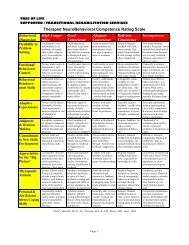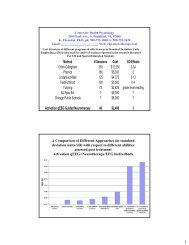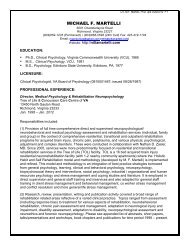Slull reacquisition after acquired brain injury - villa martelli disability ...
Slull reacquisition after acquired brain injury - villa martelli disability ...
Slull reacquisition after acquired brain injury - villa martelli disability ...
Create successful ePaper yourself
Turn your PDF publications into a flip-book with our unique Google optimized e-Paper software.
118 M.E Martelli et al. /Skill real cquisition <strong>after</strong> <strong>acquired</strong> <strong>brain</strong> <strong>injury</strong><br />
The HHR model posits that the greatest obstacle to<br />
learning or relearning is the diversion of energy away<br />
from sustained, adaptive goal directed activity and to-<br />
ward inactivity or debilitating activity. Some of the<br />
most potent habit relearning "poisons", or rehabilita-<br />
tion debilitating attitudes, are depression, anger and re-<br />
sentment, feelings of victimization, fear, and inertia.<br />
These obstacles both direct energy away from relearn-<br />
ing and inhibit it. These common catastrophic emo-<br />
tional reactions following <strong>brain</strong> injuries represent sig-<br />
nificant internal obstacles that must be removed as bar-<br />
riers before the very challenging process of relearning<br />
can be optimally engaged [32,35-37,39,40,42,44,49,<br />
501.<br />
3. The catastrophic reaction<br />
Three central postulates of the HHR model are: 1)<br />
significant emotional reactions frequently follow neu-<br />
rological injuries; 2) These reactions often exert per-<br />
sistent negative influences on post <strong>injury</strong> adaptation;<br />
3) Formal treatment of these reactions is frequently re-<br />
quired in order to optimize rehabilitation. Early post<br />
<strong>injury</strong>, an individual's discovery of traumatic loss of<br />
functional abilities and accustomed aspects of the self<br />
can be overwhelmingly devastating. The sudden loss<br />
of limb function, the inability to stand or control one's<br />
bowels, difficulty expressing a need or understanding<br />
another's speech or intentions, or inability to remember<br />
previous events can produce a powerful reaction char-<br />
acterized by acutely intense despair and distress. This<br />
response, which has been observed and described most<br />
clearly <strong>after</strong> left hemisphere cerebrovascular accidents<br />
(CVA) or other neurologic insults, has been referred<br />
to as the "catastrophic reaction" [15]. Kurt Goldstein<br />
observed that in patients with left-hehisphere CVA's,<br />
when faced with "unsolvable tasks", states of ordered<br />
behavior could "decompensate into catastrophic reac-<br />
tions" showing all the characteristics of "acute anxi-<br />
ety". Goldstein interpreted this reaction as the individu-<br />
al struggling to cope with the challenges of the environ-<br />
ment and hisher own changed body. Goldstein argued<br />
that an individual could not be divided into "organs" or<br />
"mind" and "body". Rather than tissue damage, he de-<br />
fined disease as a changed state of adaptation with the<br />
environment. This early biopsychosocial conceptual-<br />
ization posited that "healing" came from adaptation to<br />
conditions causing the new state of person-environment<br />
interaction, and not through "repair".<br />
Importantly, catastrophic or related reactions do not<br />
occur only in the context of left hemispheric lesions<br />
but may reflect a host of situational, personological, or<br />
other biomedical factors. Many post <strong>injury</strong> syndromes<br />
reflect problems in adaptation and coping with persist-<br />
ing <strong>injury</strong> sequelae. Miller [49,50] has described "neu-<br />
rosensitization syndromes" to summarize empirical and<br />
theoretical work in the area of post traumatic disabili-<br />
ty syndromes characterized by long-term demoralizing<br />
<strong>disability</strong>. Persistent postconcussion syndrome, chron-<br />
ic pain, posttraumatic stress disorder, depression, and<br />
other syndromes share many common pathophysiolog-<br />
ical mechanisms and are hypothesized to develop as<br />
the result of progressively enhanced sensitivity or re-<br />
activity of the central nervous system (CNS). A prima-<br />
ry mechanism in the perpetuation of <strong>disability</strong> in these<br />
disorders is an avoidance of stimuli that evoke anxiety<br />
and emotional distress. Because these syndromes are<br />
frequently comorbid, they can create vicious cycles of<br />
impairment and reduced quality of life.<br />
Recent research on constraint induced movement<br />
therapy (CIMT) [28,70-721 offers evidence indicating<br />
that a significant portion of <strong>disability</strong> is explained by<br />
"learned non-use" [71]. This concept is similar to<br />
Seligman's learned helplessness model of depression<br />
and coping [67]. Failure and punishment for use at-<br />
tempts early post <strong>injury</strong> can permanently suppress fu-<br />
ture efforts <strong>after</strong> acute organic damage resolution and<br />
return of potential for cerebral reorganization and re-<br />
training and regrowth for body part use. CIMT and<br />
other emerging research [16] provide empirical sup-<br />
port that neurologic <strong>disability</strong> is an adaptational phe-<br />
nomenon and that learning following <strong>injury</strong> can sup-<br />
press rehabilitation. Moreover, this suppression can be<br />
reversed through relearning to produce significant im-<br />
provements in human function even many years <strong>after</strong><br />
<strong>injury</strong>.<br />
The HHR model recognizes that the initially expe-<br />
rienced acute distress and catastrophic reactions fol-<br />
lowing <strong>injury</strong> usually become less conspicuous over<br />
time and often reach some level of resolution. How-<br />
ever, residual effects can also persist and become more<br />
subtle or concealed. Catastrophic emotional reactions<br />
can be maintained or recapitulated through continued<br />
confrontation of <strong>injury</strong> related deficits and continued<br />
requirement for compensatory efforts that are difficult,<br />
unsuccessful or result in chronic anxiety, frustration<br />
andlor resignation [18,35,37,44,59,60]. These emo-<br />
tions can easily subvert goal directed activity, energetic<br />
efforts and progress leading to feelings of powerless-<br />
ness, helplessness and being overwhelmed by the chal-








